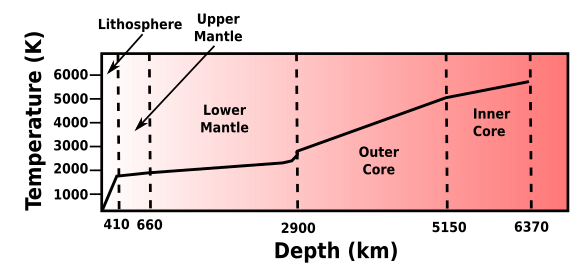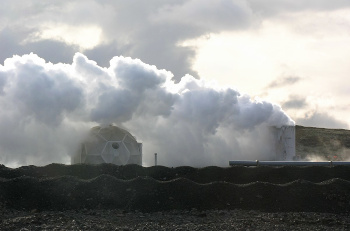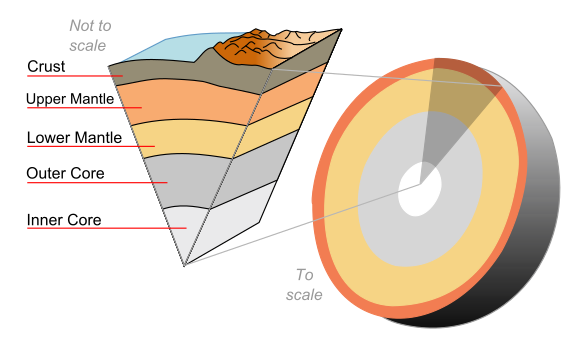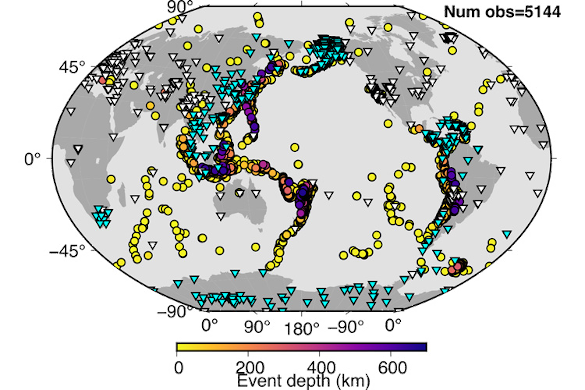Earth's Core
August 2, 2021
Humans owe our existence to certain
felicitous properties of the
Earth that allow
life to exist on its
surface. Some of these, such as
air and
water, are obvious. One overlooked property is
thermal conductivity. The Earth is a
ball of
molten metal whose
heat is
insulated by its
rocky crust.
Granite, as a representative of
igneous rock, has a thermal conductivity of about 2
W/
m/
K. This is about 200 times smaller than that of
copper (400 W/m/K), which is an excellent thermal conductor. It's the low thermal conductivity of rock, coupled with the
cold of
space, that keeps Earth's surface at the modest
temperature of
about 300 K.
In the aptly named
Hadean eon, named for the
underworld of
Greek mythology, Earth's surface was "as hot as
hell." The Hadean began with
Earth's formation, about 4.6 billion years ago, and it extended until the formation of the first rocks, 4 billion years ago. After 4 billion years of cooling, Earth maintains a
thermal gradient from its surface at about 300K to its
core of estimated temperature 5,700K (see figure). The first few
miles below Earth's surface have a thermal gradient of about 25°C/km.
Miners at the
Stillwater Mining Company platinum mine in
Nye, Montana, work about a
kilometer underground.

Thermal gradient of the Earth from crust to core. (Adapted from a Wikimedia Commons image by Bkilli1. Data from Boehler, ref. 1.[1] Click for larger image.)
Sitting atop a giant heat source has its advantages. Since
Iceland is located at a
rift between
continental plates, it has access to huge quantities of
geothermal power. According to
Iceland's National Energy Authority, its
geothermal power facilities generate 25% of Iceland's total
electric production, and geothermal sources accounts for 66% of Iceland's
primary energy use.[2] Somewhat more far-fetched, and a different take on the idea of
hot money, is
El Salvador's idea of using geothermal electric energy for
bitcoin mining.[3] El Salvador's
President,
Nayib Bukele, has stated,
"I've just instructed the president of... our state-owned geothermal electric company... to put up a plan to offer facilities for #Bitcoin mining with very cheap, 100% clean, 100% renewable, 0 emissions energy from our volcanos."[3]

The Hellisheiði Geothermal Plant in Iceland.
In the 20th century, Iceland transitioned from a country of subsistence agriculture and some fishing to industrial fishing and consumer products. As a consequence, Iceland has become one of the wealthiest nations in the world.
(Wikimedia Commons image by Hansueli Krapf)
Since it's hidden from us except by advanced scientific
measurement techniques, our understanding of the inner Earth has evolved over many years. In the late
1770s, it was noted that the
average density of
material at Earth's surface is only 3
g/
cm3, but the average density of Earth is 5.515 3 g/cm
3. This was discovered by
an experiment funded by the
Royal Society to measure the
deflection of a
plumb bob at the base of a
large mountain in Scotland, the deflection
angle giving the relative densities of the mountain and the Earth.[4] The immediate conclusion was that the core was
metallic (
liquid iron has a density of about 7 g/cm
3 at its
melting point).
Differentiation in the early, molten Earth resulted in denser materials sinking to its center and less-dense materials
floating to the crust. The dense material, believed to be 80% iron with the balance as mostly
nickel, formed Earth's core. The development of
seismology, which detects transitions between densities, found a transition at approximately 5,150 km (3,200 mi) beneath the Earth's surface between a density of about 10 g/cm
3 and 12.5 g/cm
3. This revealed the existence of an
inner core of
solid material with a
radius of about 1,220 km (760 miles), and an
outer core of liquid metal with an outer boundary about 2,890 km (1,800 miles) beneath Earth's surface.

Cross-section of the Earth. The inner core, which is about 20% of the Earth's radius, is solid because of pressure. The outer core is a liquid composed mostly of iron and nickel. Rotation of the outer core causes the Earth's magnetic field. (Modified Wikimedia Commons image by Surachit.)
As could be expected, the Earth is not precisely
spherical, and it has a
bulge at the equator that's a consequence of its
rotation. Its shape is an
oblate spheroid, but just by a little.
Sea level at either
pole is just 21 km closer to Earth's center than that at the
equator, a difference of just 21/
6370 = 0.33%. This leads to the question of whether or not the core is perfectly spherical.
An international team of
seismologists with members from the
University of California (Berkeley, California), the
Université de Nantes (CNRS, Nantes, France), the
Tokyo Institute of Technology (Tokyo, Japan), the
Collège de France (Paris, France), and the
Université de Paris (Paris, France) have discovered that Earth's solid inner core is growing faster on one side than the other.[5-6] The reason for this is unknown, but it's thought that this
asymmetrical process has been operating since the core's first
solidification more than half a billion years ago.[6] The inner core is growing faster under
Indonesia's Banda Sea, but this hasn't resulted in a
lopsided core, since
gravity distributes the new growth to maintain a spherical inner core growing in radius by a
millimeter per year.[6]

Many hands make light work, as this international team of seismologists must have discovered. This map shows the seismometer locations (triangles) at which seismic waves from earthquakes (circles) were measured to study Earth's inner core. The cyan colored stations are where new measurements were made for this study. These mostly sampled the inner core between Earth's poles. (UC Berkeley graphic by Daniel Frost)
such a growth asymmetry of the inner core suggests that something in the outer core or
mantle under Indonesia's Banda Sea is removing heat from that region at a more rapid rate than on the opposite side, under
Brazil. This heat loss would accelerate
hexaferrum iron crystallization from the outer core, causing growth of the inner core on that side.[6] Such a process would also affect the
Earth's magnetic field, since the
dynamo action of the outer core that creates this field is driven by
convection caused by the release of heat from the inner core.[6]
The discovery of this asymmetric growth explains why the crystallized iron in the core is more aligned with Earth's rotational
axis in the
west than in the
east, despite the expectation that the crystals should be
randomly oriented.[6] The research team developed a
model that describes how asymmetric growth, which is about 60% higher in the east than the west, will preferentially orient iron crystals along the rotation axis, with more alignment in the west than in the east.[6] The model also reveals that the inner core is just a billion years old, plus or minus 500 million years.[5]
As iron crystals grow,they're redistributed by gravity, which moves the excess growth from the east to the west within the inner core.[6] The inner core is somewhat
soft, having a
viscosity that's greater than 10
18 Pa-s, so the movement of the crystals aligns their
crystal lattice structure with the rotation axis of Earth, but with a greater alignment in the west than the east.[5-6] The model also predicts the proportion of nickel to iron in the center of the earth, with the result that the inner core has between 4% and 8% nickel.[6] This is about the proportion in metallic
meteorites.[6] Funding for this research was provided by the
National Science Foundation.[6]
References:
- Reinhard Boehler, "Melting Temperature of the Earth's Mantle and Core: Earth's Thermal Structure." Annual Review of Earth and Planetary Sciences, vol. 24 (May 1996), pp. 15-40, https://doi.org/10.1146/annurev.earth.24.1.15.
- Geothermal, Orkustofnun - National Energy Authority of Iceland Website.
- Danny Nelson, "Volcano-Powered Bitcoin Mining Goes From Twitter Idea to State Policy in El Salvador," coindesk.com, June 9, 2021.
- R. D. Davies, "A Commemoration of Maskelyne at Schiehallion," Quarterly Journal of the Royal Astronomical Society, September, 1985.
- Daniel A. Frost, Marine Lasbleis, Brian Chandler, and Barbara Romanowicz, "Dynamic history of the inner core constrained by seismic anisotropy," Nature Geoscience, June 3, 2021, https://doi.org/10.1038/s41561-021-00761-w.
- Robert Sanders, "Is Earth's core lopsided? Strange goings-on in our planet's interior," University of California, Berkeley, Press Release, June 3, 2021.
Linked Keywords: Human; felicitous; material properties; Earth; life; lithosphere; surface; atmosphere of Earth; air; water; thermal conductivity; sphere; ball; melting; molten; metal; heat; thermal insulation; insulated; rock (geology); crust (geology); granite; igneous rock; watt; meter; kelvin; copper; cold; outer space; temperature; standard conditions for temperature and pressure; Hadean; geologic time scale; eon; underworld; Greek mythology; hell; history of Earth; Earth's formation; geothermal gradient; thermal gradient; structure of Earth - core; mile; miner; Stillwater Mining Company; Nye, Montana; kilometer; Wikimedia Commons; Iceland; rift; plate tectonics; continental plate; geothermal power in Iceland; Iceland's National Energy Authority; geothermal power facility; electric power; electric production; primary energy; hot money; El Salvador; bitcoin mining; President of El Salvador; Nayib Bukele; president (corporate title); enewable energy; greenhouse gas emission; volcano; 20th century; country; subsistence agriculture; fishing; industrial fishing; final good; consumer product; wealth; world; Hansueli Krapf; scientific instrument; measurement technique; 1770s; average; density; material; gram; cubic centimeter; cm3; Schiehallion experiment; funding of science; Royal Society; deflection (engineering); plumb bob; Schiehallion mountain in Scotland; angle; metal; metallic; liquid; iron; melting point; planetary differentiation; buoyancy; float; nickel; seismology; Earth's inner core; solid; radius; Earth's outer core; cross section (geometry); pressure; rotation; Earth's magnetic field; Surachit; equatorial bulge; rotation; oblate spheroid; sea level; geographical pole; equator; Earth radius; seismologist; University of California (Berkeley, California); Université de Nantes (CNRS, Nantes, France); Tokyo Institute of Technology (Tokyo, Japan); Collège de France (Paris, France); Université de Paris (Paris, France); asymmetry; asymmetrical; freezing; solidification; Indonesia; Banda Sea; lopsided; gravitation; gravity; millimeter; Many hands make light work; map; seismometer; triangle; seismic wave; earthquake; circle; cyan; Earth's pole; Daniel Frost; mantle (geology); Brazil; hexaferrum iron; crystallization; Earth's magnetic field; dynamo theory; dynamo action; convection; rotation axis; west; east; randomness; random; scientific modelling; model; hardness; soft; viscosity; pascal (unit); crystal lattice structure; meteorite; National Science Foundation.